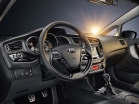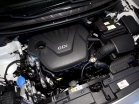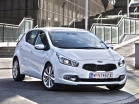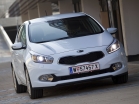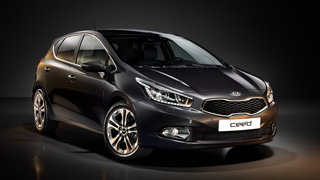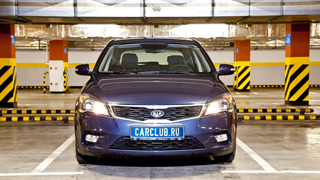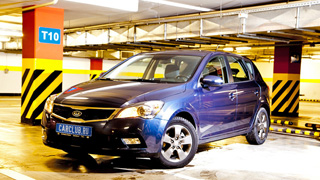KIA CEED test drive since 2012 Hatchback
Long -term test kia cee`d: frost and sun
The second week we have a KIA CEED test. We wrote about the European Hatchtek design last time, now it's time to evaluate dynamics and controllability.
In our CEED market, only two engines are offered. Both engines are four -cylinder gasoline with a volume of 1.4 and 1.6 liters. The basic equipment is equipped with a 1.4-liter motor with a capacity of 109 hp. and five -speed mechanics. The vast majority of sidov are 1.6 -liter. The capacity is 122 hp, declared acceleration to 100 km/h with a manual transmission 10.8 seconds, with an automaton - 11.9 seconds.
The dynamic characteristics of the Kia CEED are quite consistent with the average family hatchback from the budget price category. Despite the fact that the engine power is only 122 hp, the Korean atmosphere is completely good. He is cheerful at the top and actively responds to press the gas pedal.
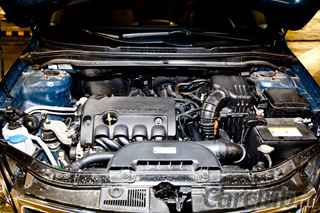
In a 122-horsepower four-cylinder gasoline engine, a groovy character, which is revealed after 3000 thousand revolutions. I remember, in 2006, when the CEED only made their debut, the Koreans were one of the first who removed from 1.6 liters of volume of more than 120 hp. If for six years, the potential of the engine has not lost its relevance, then an obsolete four -speed automatic speed of operation is significantly lags behind more modern analogues.
But the four -band machine is frankly outdated. The box not only switches the gears with a noticeable delay, but also clearly underestimates the potential of the engine. KIA starts well from the bottom, then a failure in the middle and tangible picking up on top should be followed, which is accompanied by a rather annoying rumble of the motor, which falls into the salon through insufficiently strong sound -insulating redoubts between the motor compartment and the salon.
By the way, the rest of the places are also isolated less than we would like. Passengers can be heard by the camer of the pebbles on arches and aerodynamic noises from side mirrors, and the sounds of music playing in the cabin are heard to pedestrians.
Given the frosts, which the first two weeks of the Kia Ceed test fell out, the mixed consumption of 95th gasoline amounted to about 10.8 liters. Of course, this is not a record of gluttony, but significantly more appetite of modern analogues. True, there is a non -reasonable assumption that an automatic transmission should also be asked for consumption.
The steering wheel is moderately tight with a well -verified effort. When working with the steering wheel, a good feedback level is felt. Of course, the artificial effort created by electronics is inferior to European analogues, but the information content is not bad, and an adequate surge of effort is felt at high speed. You can only complain about the spread of reactions in a bend at medium speeds caused by an excess of synthetics.
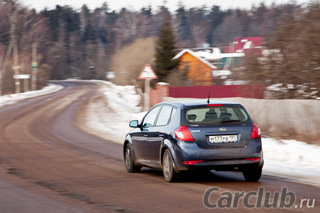
KIA CEED is well steel and overcomes turns with a little roll. On a flat road, hechtbek is assembled and stable in European, but as soon as the asphalt spoils of itself, a harsh suspension makes itself felt.
On a flat straight seat is good. The hatchback clearly follows a given course, does not get down due to the aerodynamic swirls of oncoming trucks and does not dance much in the ruts. Impressions on the highway require a minimum. In general, the KIA CEED chassis was configured with a clear eye on a good coating. In a bend, he justifies his European roots with collected behavior and small rolls, and with high -speed driving along the highway, the lack of buildup.
As soon as good asphalt ends, the hatchback becomes tough and shaking. Light dumps from cracks in the coating and dull blows from large pits are transferred to the salon. At the same time, the irregularities of any caliber are hard and loud, and large bumps may well provoke breakdown. However, it is worth making a reservation that the first two weeks with Sid fell on severe frosts, when the thermometer reads to 30 frost.
At such temperatures, shock absorbers and rubber silent blocks are tanned by order. The reactions become much sharper and tougher, and suspicious knocks appear in the bowels of the chassis. Together with warming, the test Kia Ced was slightly fled: there were fewer knocks in the rear suspension, reactions to unevenness were slightly smoothed. Now Sid has become more friendly, but the chassis settings for our roads are still harsh.
In winter conditions, with a often slippery road, it will also be useful to mention the work of the stabilization system. I liked her algorithm. ESP knows his work and begins to adjust the driver’s actions precisely when it becomes necessary. It allows you to slightly correct the car with a handbrake, but at the same time it does not allow dangerous drift angles when a real threat of management loss appears.
The brakes were pleased with efficiency, but the pedal force was poorly worked out, which is why Kia pecks with the nose even with the slightest touch. To this, I have not yet been used to getting used to it even after two weeks in the company with Sid and almost a thousand kilometers passed.
You can summarize. Kia Ced solid family haschtbek with a painful engine and good handling, and its main shortcomings are an old tight automatic transmission and an uninformative brake pedal. However, these shortcomings should be corrected very soon, when a new generation will take place. But more on this a little later, and in the following material we will talk about the price, the cost of service and the main competitors.
To be continued
Source: Carclub.ru

